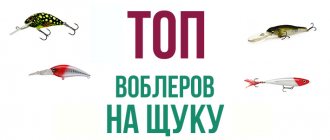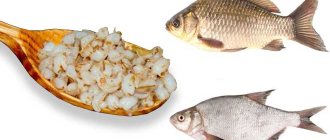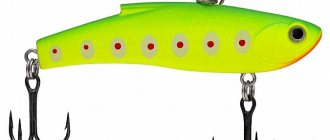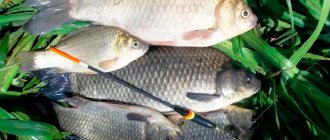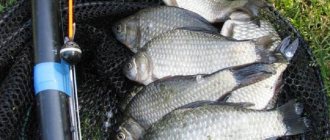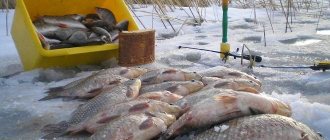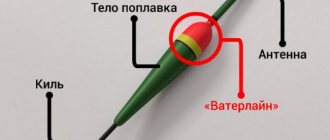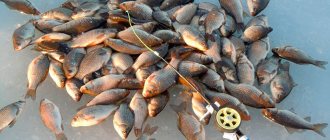Donka
This is a special type of fishing rod. The design is a symbiosis of a fishing line with a load and a leash with a hook. The tackle is thrown into the water, where it is fixed with a sinker. It has several varieties:
- snack;
- rubber;
- donka with a float;
- feeder equipment;
- running gear;
- makushatniki (“satellites”);
- returnable;
- winter.
For winter fishing, a different design is used. The nod, to which the reel is attached, is attached to a fishing rod made of hardwood. The fishing rod crashes into the ice, where it freezes.
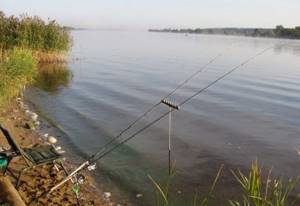
At the moment when the fish swallows the bait, the nod shudders and begins to swing continuously. His movements can be observed from a distance.
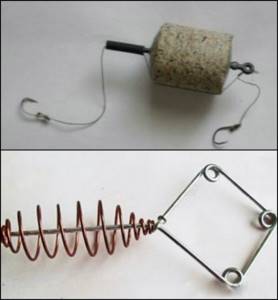
It should be noted that bottom tackle is easy to make with your own hands.
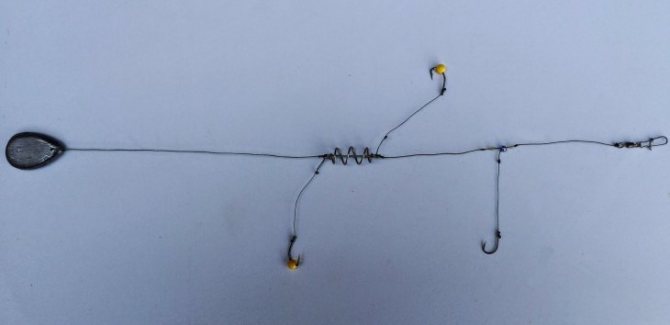
Rubber band for catching crucian carp
This tackle is nothing more than thick rubber with a heavy sinker at the end. Usually the elastic band is about 10 meters long. It is attached to a fishing line on which 3-10 hooks with leashes are placed. The convenience of this gear is that it is cast at the beginning of fishing and reeled in at the end.
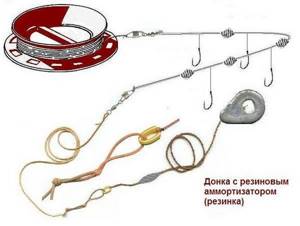
Hooks on the bottom are placed at a distance of 15-25 centimeters, which allows fishing at different depths. For a better bite, you can attach a small feeder to the fishing line. We can see the bite by looking at the guard or, if desired, you can hang a small bell. Inconvenience when fishing can be caused by tangling of hooks.
Pulling out the elastic can also spoil the mood, since the bottom is sometimes silted, and the load is simply difficult to pull out, and most often you have to tear off the load and, accordingly, shorten and damage the elastic. To avoid this, it is worth tying a separate strong fishing line to the load in the form of a safety line. And when you finish fishing, pull it not by the elastic band, but by the neutral line.
Which fish to choose?
First of all, the inhabitants of lakes and rivers look for food at the bottom. Among them: perch, catfish, ide, carp, crucian carp, and others. The donka was created specifically for catching them.

Instructions on how to choose bottom tackle
When choosing a donkey, several factors are taken into account. They significantly affect fishing. For fishing to be successful, you need to pay attention to:
- Characteristics of the reservoir (is there a current, is the water calm).
- Availability of fish to be caught.
- The strength of the current.
- Distance (fishing from the shore, fishing from a boat).
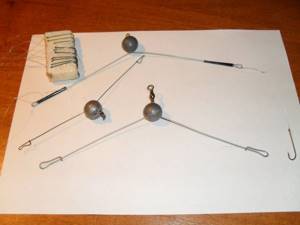
Bottom fishing can have obstacles. Driftwood and bottom algae can interfere with successful fishing. However, there are special techniques that help get rid of obstacles.
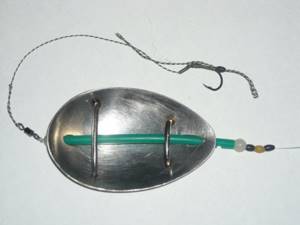
Feeders
Needed for catching non-predatory fish. Structurally very similar to the donks described above, the difference lies in the frequency of casting. This should be done every five minutes, regardless of whether there is a bite. Externally they are similar to spinning models, but have their own classification according to class, length, and action.
Jig fishing - fishing technique and spinning equipment rules

This tackle has the following features:
- Selection by test. Depends on the weight of the feeder - from 60 to 200 g.
- The length of the rod varies from 3.3 to 4.6 m;
- The coils used are inertialess.
The recommended spool volume of the latter is from 3000 to 6000. Installation of the cord or fishing line can be carried out in one of three ways - symmetrical, asymmetrical, inline or Gardner loop. The type of fish feeder is open, of various shapes. Recommended manufacturing material is plastic. In the latter case, you definitely need a weight.
Evolution
When the first examples of bottom gear appeared, they did not have reels, and some did not have rods. The line had to be wound onto the reel. It was also difficult to make long casts.
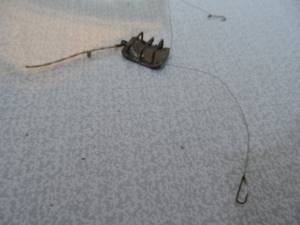
The situation was radically changed by the appearance of improved bottom tackle: with telescopic and plug-in rods. Novice fishermen began to use new models. Experienced ones preferred homemade devices.

Zakidushka
How to make bottom tackle? It is the bait, the ancestor of all types of gear for bottom fishing, that you can make yourself. A sinker is attached to a piece of fishing line, which is placed at the end. The design includes 3-4 leashes with hooks.
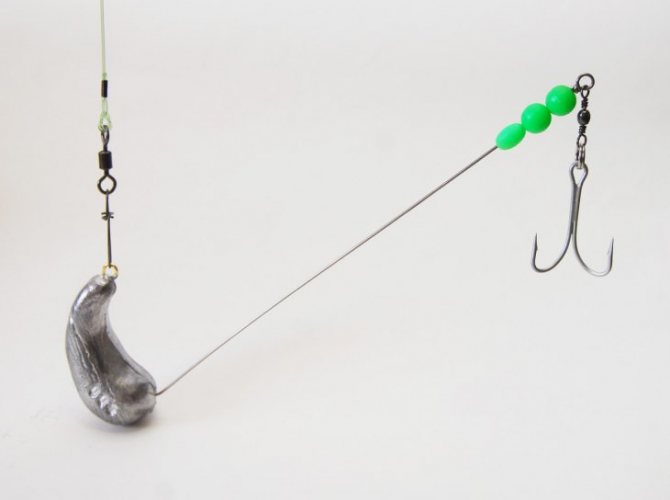
In the old days, a hook was a fishing line wound on a reel made of wood. During fishing, it stuck into the sand. After casting, the line was stretched and fixed on the stand. A bell attached to an elastic band rang when a fish grabbed the bait. Instead of a fishing rod, many used long sticks, pointed at one end. They were stuck into the sand, providing support for the structure.

Fishing rods
Needed for float fishing. Structurally they resemble spinning rods, but they are lighter and simpler in shape. Can be used with or without coils. To increase fishing efficiency, you need to choose the right equipment for each type of fishing rod: fishing line, float, type of weight and hook.
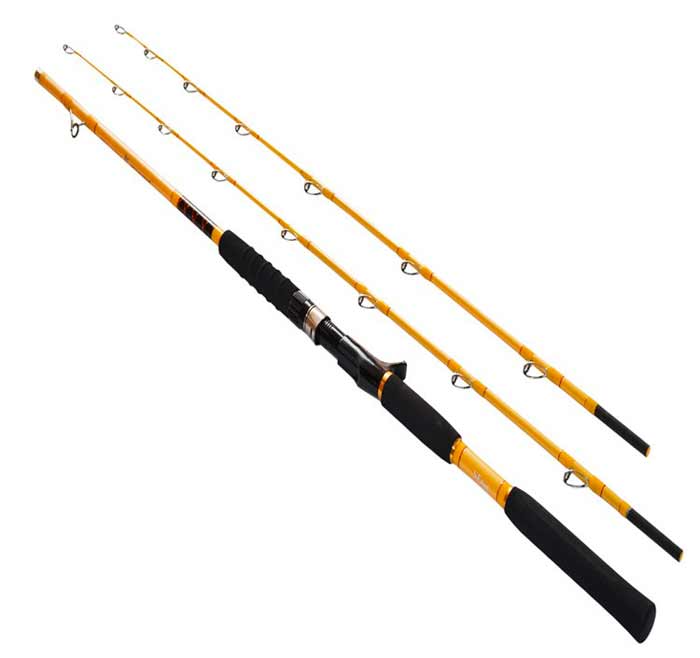
Common types of fishing rods:
- Bolognese. Size - from 4 to 7 meters, used in fishing in slow currents or in standing water. Hard models are designed for long casts, while soft ones respond better to small fish biting.
- Fly feathers. They are characterized by minimal weight with a maximum length of up to 8 m. The design does not provide rings for fishing line, and there is also no possibility of installing a reel. The area of application of this fishing equipment is fishing by hand. Their equipment is replaced quickly due to its simplicity.
- Match. Needed for long casts, characterized by large mass. Fishing gear of this type consists of three parts. A special feature is the use of a sinking fishing line. Maximum length – up to 5.5 m.
What pressure is better for fishing in summer and winter: high, low or normal?
When choosing, you need to take into account the rigidity of the rod and the correct selection of fishing line. Telescopic models can be equipped with various types of reels.
When the cold comes
Winter bottom tackle is not very often used by fishermen. But you can also catch a lot of fish with it, since in winter it feeds at the bottom. The structure consists of the following components:
- fishing rod (fishing rod);
- nod;
- coil;
- fishing line;
- equipment

The load is taken sliding, weighing 10-15 g, in the shape of an olive. It is threaded through a line whose diameter should vary from 0.16 to 0.2. With a rapid current, the weight of the load can be 20 g. The fishing line is also thicker.
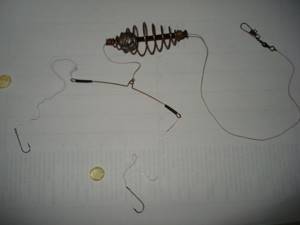
Feeder tackle
The feeder rod (detailed article on how to choose) should be chosen depending on the conditions (reservoir, weather).
So, for large bodies of water with strong currents (rivers, reservoirs), a tackle with a large rod weight of up to 120 g is suitable. For small bodies of water, a tackle with a rod up to 60 g and a small feeder is suitable. Rods with a length of 3.5 - 4 meters are the most versatile and have a good price-quality ratio. When choosing a feeder, you should take products weighing slightly less than the test rod, since the rest of the weight will be “taken” by the bait. The bait should also correspond to the reservoir (recipes for crucian carp bait). When fishing on a body of water with a strong current, the bait should be dense enough so that it does not wash away, and on reservoirs with a weak current or standing water - as light as possible so that it does not sink in the muddy bottom. For the latter option, a base of breadcrumbs is suitable.
To prevent the fish from quickly getting enough and thus losing interest in the bait, the components of the bait must be small. Crucian carp do not have specific taste preferences, so there can be no unambiguous and clear advice on how to make bait. For scent, you can add a little grated garlic, ground seeds, vegetable oil or even ground cookies to the bait.
Baits. As with bait, there is no advice on what to fish with. The taste preferences of crucian carp can change even during the day. We can only say that crucian carp bite well on pearl barley, pasta, corn, pancakes, and rye bread dough flavored with garlic.
A fishing line with a cross section of 0.12 mm is suitable. If there is a chance of carp or other strong fish biting, it is better to take a fishing line of about 0.2 mm. The leash should be made in this case from a thinner fishing line. The nozzle should be such that small things like roach or bleak cannot swallow it. It is better to use hooks from No. 5 – 7 to No. 9. The latter is suitable for large crucian carp. Also, the hooks should be as sharp as possible, otherwise there may be problems with hooking fish.
Tops (quivertips) , like other tackle, should be selected depending on the conditions. In the current and in the wind, the tip should not be very sensitive so as not to react to these factors and not create false bites. When fishing on a still body of water in calm weather, it should be more sensitive so that the angler can see even the most sluggish bite.
The simplest equipment for crucian carp is a paternoster.

The technique of catching crucian carp with a feeder is described in the corresponding article on our website.


